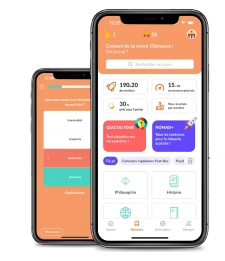A general practitioner (UK) or a family physician (US) usually performs a physical examination of the patient in an exam room on an exam table. (une table d’examen)
A pen light helps shed light into dark places. (une lampe stylo)
An otoscope helps in an ear examination. (un otoscope)
A stethoscope is used to listen to the heart and the lungs. (un stéthoscope)
To measure the patient’s blood pressure, doctors use a tensiometer. (un tensiomètre)
To check the temperature, you can use a thermometer. (un thermomètre)
A pulse oximeter measures the level of oxygen saturation in the patient’s blood. (un oxymètre de pouls)
A glucometer measures the concentration of glucose in blood. (un glucomètre)
To assess body weight, a doctor uses a body weight scale (un pèse-personne)
A baby scale helps determine the weight of an infant. (un pèse-bébé)
A growth chart can be used to measure height. (une toise)
An ECG unit is used to monitor heart functions. (un électrocardiogramme)
Eye charts can help check visual acuity. (un tableau optométrique)
A refrigerator can be used to store and preserve vaccines. (un réfrigérateur)
Any used needles must be disposed of in a safety sharps container. (un collecteur d’aiguilles)
Soiled disposable equipment is stored in an infectious waste bin. (un collecteur de DASRI)
A computer is now a necessary tool for any doctor. (un ordinateur)
Doctors have to fill out their electronic health record (un dossier medical informatisé) and transmit them through a health secure patient messaging system. (une messagerie sécurisée)
Patients must produce a certificate of health coverage or a health care card. (une carte d’assurance maladie)
Doctors write a prescription so that the patient can go to the pharmacy and purchase medicine. (une ordonnance)
If further care is needed, the doctor may refer the patient to a specialist or a hospital. (adresser le patient)



